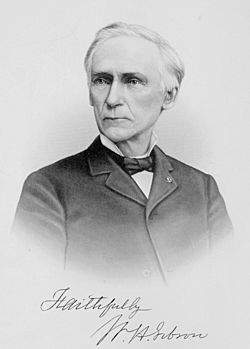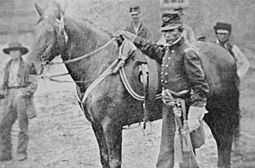William Harvey Gibson facts for kids
Quick facts for kids
William Harvey Gibson
|
|
|---|---|

circa 1879
|
|
| 9th Ohio State Treasurer | |
| In office January 14, 1856 – June 13, 1857 |
|
| Governor | Salmon P. Chase |
| Preceded by | John G. Breslin |
| Succeeded by | Alfred P. Stone |
| Personal details | |
| Born | May 16, 1821 Cross Creek Township, Jefferson County, Ohio |
| Died | November 22, 1894 (aged 73) Tiffin, Ohio |
| Resting place | Greenlawn Cemetery, Tiffin |
| Political party | Republican |
| Spouse | Martha Matilda Creeger |
| Alma mater | Ashland College |
| Military service | |
| Allegiance | United States |
| Branch/service | Union Army |
| Years of service | July 31, 1861 - September 5, 1864 |
| Rank | |
| Unit | 49th Ohio Infantry Horn Brigade |
| Battles/wars | Battle of Shiloh Siege of Corinth Battle of Stone River Tullahoma Campaign Battle of Chickamauga Battle of Missionary Ridge Atlanta Campaign Battle of Resaca Battle of Pickett's Mill Battle of Kennesaw Mountain Siege of Atlanta Battle of Jonesboro Second Battle of Franklin Battle of Nashville |
William Harvey Gibson (born May 16, 1821 – died November 22, 1894) was an important politician from Ohio. He started his career in the Republican Party. He once had to leave his job as the Ohio State Treasurer because of financial issues. However, he later became a respected Brigadier General in the Union Army during the American Civil War. He led the 49th Ohio Volunteer Infantry.
Contents
Early Life and Education
William Harvey Gibson was born on May 16, 1821. His family lived in Cross Creek Township, Jefferson County, Ohio. His parents were John and Jeannette Gibson. They taught their children to work hard and be kind. They also believed in being sober and helping those in need. The family was against slavery.
The Gibson family loved to debate. They often held family debates during long winter evenings. This helped William and his siblings become good speakers.
Family History
William's family had a long history in America. On his mother's side, he was related to Robert Coe. Robert Coe came to America in 1634. William's father's family came from Scotland and Ireland. His grandfather, Colonel John Gibson, was a soldier in the American Revolutionary War. He also served as the Acting Governor of Indiana Territory.
Moving to the Frontier
When William was only four months old, his family moved. They settled in Melmore, Ohio, in Seneca County, Ohio. This area was a wild frontier back then. Seneca and Mohawk Native Americans lived there. William remembered being baptized with ten Native American children. He also heard Chief "Grey Eyes" preach. The Gibson brothers would take their corn to a mill built for the Wyandotte Indians.
School Days
William went to the first school in Seneca County, Ohio, in 1826. It was in a log cabin. Later, the community built a one-room log schoolhouse. It was called Craw's Hill School. Some of William's schoolmates became famous. They included Anson Burlingame, a diplomat, and Charles Foster, who became the Governor of Ohio.
Exploring the West
As a teenager, William wanted to explore the American West. He traveled with his brother Robert and two neighbors to the Iowa Territory. The trip was very difficult. William and Robert eventually returned home. Their youngest brother, James Allen Gibson, later moved to Kansas.
Learning at Ashland Academy
In 1841, William and his brother Robert went to Ashland Academy. This school later became Ashland University. William improved his debating and speaking skills there. He was known for his strong views against alcohol. He also learned carpentry and studied law.
Early Career in Law and Politics
William Harvey Gibson decided to become a lawyer. He studied law with Abel Rawson. He became a lawyer in Ohio. His first case was defending someone against unfair comments.
Joining the Whig Party
Gibson became active in politics. He joined the Whig Party. This party was strongly against slavery. In the 1844 election, he gave speeches for Henry Clay. Clay's party did not want Texas to join the United States as a slave state.
Gibson supported Zachary Taylor in the 1848 election. However, he worried that the Whig Party was not doing enough to end slavery. He even visited Henry Clay to talk about it.
Founding the Republican Party
After the Whig Party lost many elections, Gibson looked for a new political home. He joined the Free Soil Party. Then, he helped create the Republican Party in Ohio. He attended the first Republican National Convention in 1856. That same year, he was elected as the first Republican Ohio State Treasurer.
State Treasurer
In 1855, Gibson won the election for Ohio State Treasurer. He defeated John G. Breslin. Gibson started his job on January 14, 1856. He found that the treasury was missing a lot of money. He spoke to Breslin, who promised to fix the problem.
When the money issues became public, Gibson had to resign. He left office on June 13, 1857. An investigation found that Gibson did not take money for himself. Instead, he was involved in trying to keep the problem a secret. Breslin moved away to avoid legal trouble. Gibson returned to Tiffin, Ohio and opened a law office.
Civil War General
William Harvey Gibson joined the Union Army on July 31, 1861. By August 31, he was named Colonel of the Forty-Ninth Regiment, Ohio Volunteer Infantry. He led this regiment throughout the entire Civil War. In 1861, he organized and trained his soldiers at Camp Noble, near his home in Tiffin.
Under Gibson's command, the 49th Ohio Infantry fought in 42 Civil War battles. Some of these important battles included:
- The Battle of Shiloh
- The Siege of Corinth
- The Battle of Stone River
- The Tullahoma Campaign
- The Battle of Chickamauga
- The Battle of Missionary Ridge
- The Atlanta Campaign (including the Battle of Resaca, Battle of Kennesaw Mountain, and Siege of Atlanta)
- The Battle of Jonesboro
- The Second Battle of Franklin
- The Battle of Nashville
Gibson was known for his strong leadership. His soldiers admired his positive speeches. He was always willing to lead from the front in battle. At the Battle of Shiloh, three horses were shot from under him. He was also wounded by a bayonet.
Gibson left the army on September 5, 1864. He was later given the honorary rank of Brevet Brigadier General on March 13, 1865.
In his hometown of Tiffin, Ohio, there is a bronze statue of William Harvey Gibson. It is called the William Harvey Gibson Monument. It stands on the grounds of the Seneca County Courthouse. His soldiers helped raise money for this statue.
After the Civil War
After the Civil War, General Gibson went back to being a lawyer. In 1868, he ran for Congress in Ohio, but he lost. In 1871, he helped plan the town of Gibsonburg. He continued to give speeches for Republican politicians.
In the 1880s, Gibson became a preacher in the Methodist Episcopal Church. He was also appointed as the Ohio Adjutant General. This was a high military position in the state. In 1887, he was appointed to the Ohio Canal Commission.
Legacy
William Harvey Gibson is remembered for his amazing speaking skills. He was known for his powerful speeches during a difficult time in American history. The famous author Harriet Beecher Stowe praised his speaking ability. She said she had never heard such great speaking.
When Gibson died in 1894, William McKinley gave the eulogy. McKinley was the Governor of Ohio at the time. He later became the President of the United States.
William Harvey Gibson was buried in Greenlawn Cemetery in Tiffin, Ohio. He married Martha Matilda Creeger on May 25, 1847. She was from Maryland.


